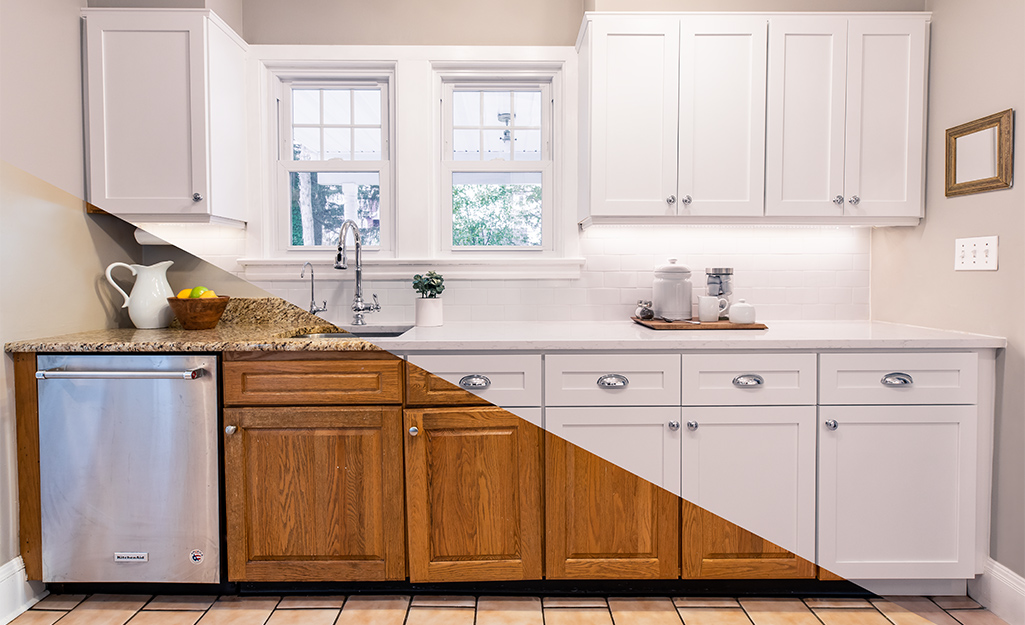Kitchen Cabinet Refacing vs. Replacement
Kitchen Cabinet Refacing vs. Replacement: What’s Best for Your London Home?
Thinking about giving your kitchen a facelift but not sure whether to reface or replace your cabinets? You’re not alone. Many London homeowners come to me unsure which route offers the best bang for their buck—and most importantly, what actually fits their home and lifestyle.
Let’s walk through the pros, cons, real costs, and customer experiences to help you make the right choice.
What’s the Difference? Refacing vs. Replacing
🛠 What is Cabinet Refacing?

Cabinet refacing is basically giving your kitchen a fresh coat of style without tearing everything apart. It involves:
- Replacing cabinet doors and drawer fronts
- Applying a new veneer to the existing cabinet boxes
- Swapping out hinges, knobs, and handles
💬 “We had our dated maple kitchen refaced with navy shaker doors and gold handles. It looked like a brand-new kitchen for a third of the price!” — Priya, Islington
Refacing typically takes 3–5 days, causes minimal mess, and keeps your existing layout intact.
🧱 What is Cabinet Replacement?

Cabinet replacement is a full renovation. That means removing your old cabinets and installing entirely new units, which opens the door to:
- Changing the layout
- Installing new storage solutions
- Using completely different materials (like solid wood or high-gloss acrylic)
But this route is more time-consuming and expensive—often taking 2–5 weeks, depending on scope.
💬 “We went for a full replacement because our old carcasses were falling apart and we wanted a kitchen island. Yes, it cost more, but it completely changed how we use the space.” — James & Liz, Walthamstow
Price Comparison: Refacing vs. Replacing in London
Here’s a quick side-by-side comparison of what you can expect to spend in London:
| Option | Average Cost Range (London) | Notes |
|---|---|---|
| Refacing (Laminate) | £1,100 – £2,700 | Affordable, wide choice of colours |
| Refacing (Wood Veneer) | £2,400 – £5,500 | Higher-end look, more durable |
| Replacement (Standard) | £4,000 – £10,000+ | Depends on size, layout, materials |
| Replacement (Bespoke) | £10,000 – £25,000+ | For full custom kitchens |
💡 Tip: If your carcasses are solid and layout works, refacing can save you 30–70% of the cost of a full replacement.
When to Reface… and When to Replace
✅ Go for Refacing If:
- Your cabinets are structurally sound (no warping or water damage)
- You’re happy with the current layout
- You want a fast, affordable refresh
- You’re aiming for eco-friendliness (refacing = less landfill waste)
💬 “We didn’t want to rip out a perfectly functional kitchen. The doors were just dated. Refacing gave us a fresh look in a few days.” — Tom, Camden
❌ Consider Replacing If:
- Cabinets are damaged, warped, mouldy or made of chipboard
- You need a layout change (like adding an island or tall pantry units)
- You’re after high-end finishes or smart storage
- You want to increase your home’s resale value
Pros & Cons Breakdown
🔄 Cabinet Refacing
Pros
✔️ More affordable than replacement
✔️ Quicker turnaround
✔️ Less mess and disruption
✔️ Sustainable choice
✔️ Huge variety of colours, handles, finishes
Cons
❌ Doesn’t fix layout or structural issues
❌ Still depends on the quality of existing cabinet boxes
❌ Veneer may wear faster than solid wood
❌ Can still be costly for premium finishes
🆕 Cabinet Replacement
Pros
✔️ Customisable layout and storage
✔️ Repairs structural issues
✔️ Higher value for resale
✔️ Longer lifespan
Cons
❌ More expensive
❌ Requires more time and trades (plumbing, electrics)
❌ Can be messy and inconvenient
What Styles Are Popular in London Right Now?
Here’s what’s trending with my London clients:
For Refacing:
- Matte navy blue or forest green shaker doors
- Gloss white handleless cabinets
- Textured wood-effect laminate in grey oak
- Brass or matte black hardware for contrast
For Replacements:
- Bespoke in-frame Shaker with hand-painted finish
- Scandi-style white oak and plywood mix
- Integrated pull-out pantries and spice drawers
- Waterfall-edge islands with quartz tops
Can You DIY This?
🔨 Refacing can be DIY’d if you’re handy, have the right tools, and a good eye for detail. But keep in mind:

- Veneer sheets are tricky
- Fitting new doors needs precise measuring
- Misaligned doors or drawers look sloppy
For most London homes, I still recommend hiring a professional kitchen fitter—especially if your kitchen is part of an open-plan space.
🧰 Replacement, on the other hand, is definitely a job for the pros. You’ll likely need:
- Joiners
- Electricians
- Plumbers
- Possibly planning approval if structural changes are made
FAQs
❓ How long will a refaced kitchen last?
Refaced kitchens can last 10–20 years, especially with quality veneers and hinges.
❓ Is refacing worth it if I might sell my home?
Yes—buyers often love a refreshed look. But if you’re after maximum resale value, full replacement might return more in high-end London markets.
❓ Can I reface AND add a few new cabinets?
Yes! Many homeowners add new cabinets alongside refacing for a hybrid approach—cost-effective and functional.
❓ Will I need to change my worktops too?
Only if you want to. Most refacing jobs keep existing worktops. For full replacement, it’s standard to replace both cabinets and counters.
Final Thoughts
If your cabinets are solid and your layout works, refacing is a smart, stylish, and cost-effective option. But if your kitchen needs more than just a fresh face—say, better storage, layout changes, or upgraded materials—replacement is worth the investment. As a kitchen designer working in London, we’ve helped clients transform their homes using both routes. The best choice really depends on your goals, budget, and how you use your kitchen every day. Still unsure? Book a design consultation and we’ll walk through your options together—no pressure, just honest advice.










Comment (1)
[…] 👉 If you want a more technical comparison with detailed breakdowns, check out our full guide on Kitchen Cabinet Refacing vs. Replacement. […]
Comments are closed.